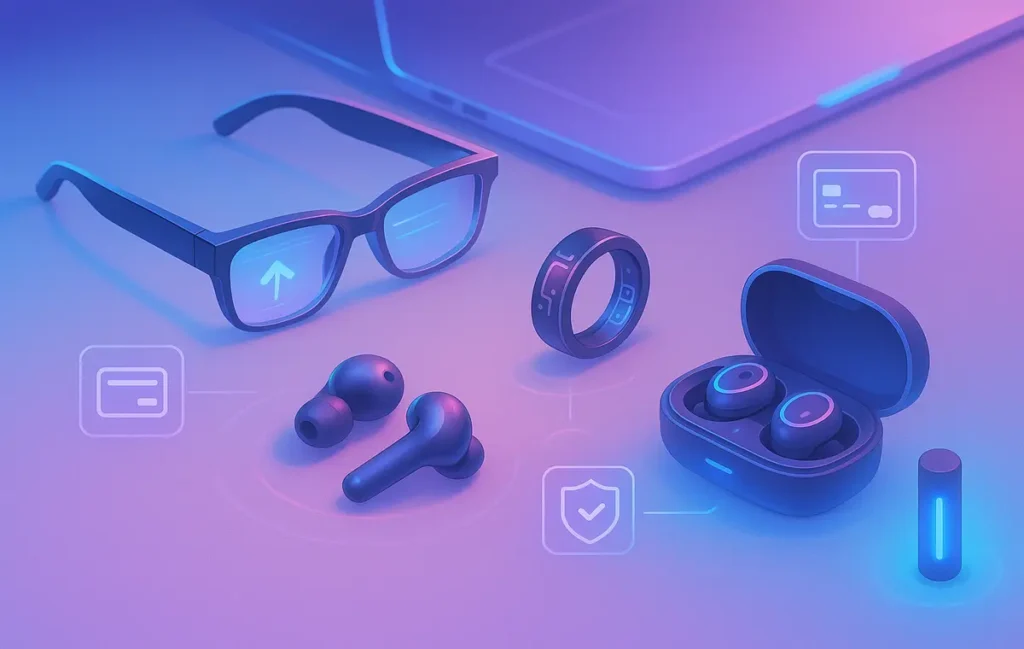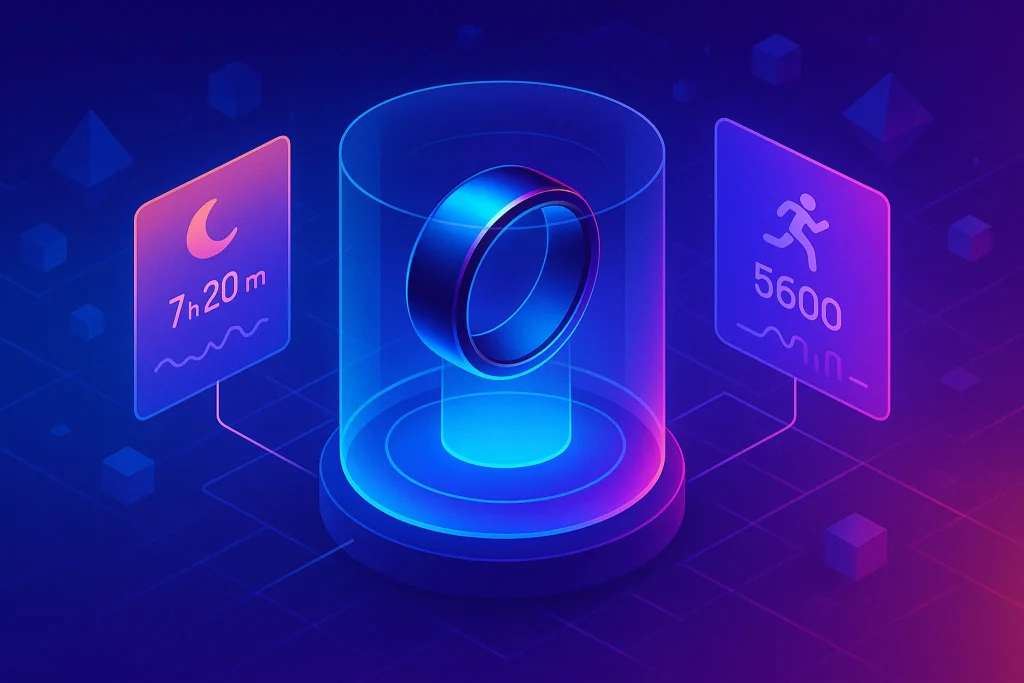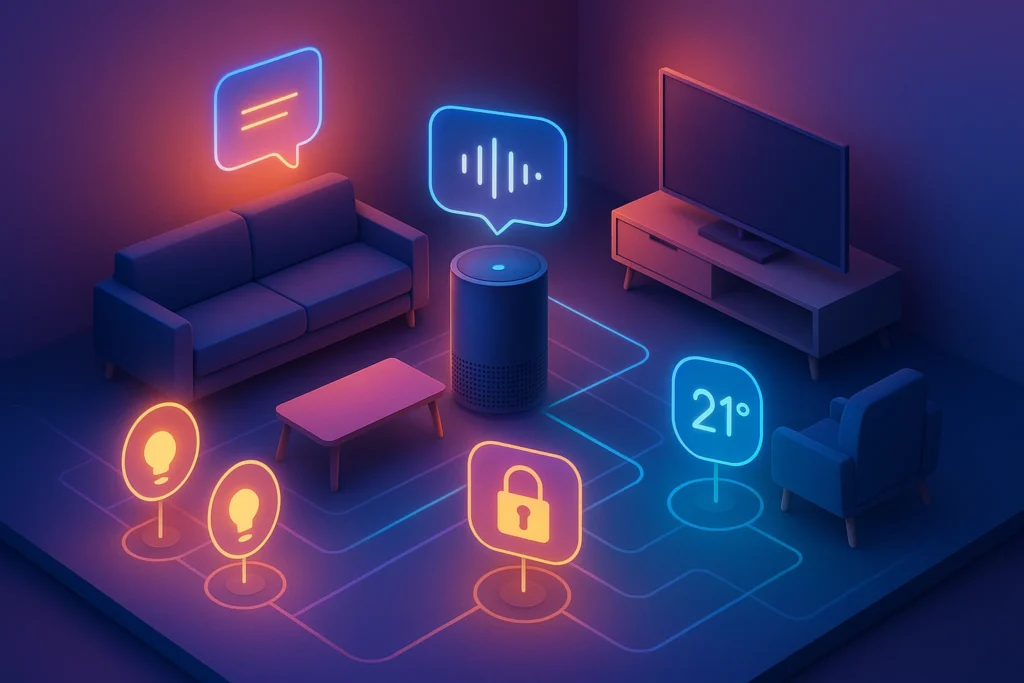🌟 Intro: Wearables Are Graduating From Step Counters
For a decade, wearables were mostly a health story—counting steps, logging sleep, nudging you to stand up. Useful, yes. But 2025 marks a decisive shift: the most interesting wearables have little to do with calories. They’re about action and access. Glasses that translate languages on the fly. Rings that unlock doors and pay for coffee. Earbuds that transcribe meetings and summarize action items. Discreet safety devices that escalate help to trusted contacts. Haptics and gesture controls that let creators perform, design, or game without touching a screen.
At NerdChips, we see the new wave of wearables as a practical computing layer that lives closer to your senses and routines than a phone ever could. If you’ve only followed step charts and VO₂ max graphs, you’re missing the most exciting story in personal tech. This guide is your pillar on everything beyond fitness—what matters, what works, and how to choose a setup that genuinely gives you superpowers.
💡 Nerd Tip: If a wearable can be replaced by a phone app with two taps, it’s probably not transformative. Prioritize devices that reduce friction to almost zero—tap, glance, or speak and the task is done.
(If you want the health-first overview of watches and trackers, see our general primer on Wearable Tech—this post deliberately focuses on productivity, payments, AR, safety, and creative experiences.)
🕶️ The New Wave of Wearables: Beyond Fitness, Into Utility
When you stop treating wearables as a bundle of sensors and start seeing them as micro-computers on your body, your buying criteria change. Instead of asking “how accurate is the heart-rate graph?”, you ask:
-
Does this replace a handful of tiny phone moments I repeat all day?
-
Does it unlock scenarios where using a phone is slow, awkward, or unsafe?
-
Does it integrate with ecosystems I already use—identity, payments, communication, productivity?
Four categories dominate the non-fitness wave: smart glasses, payment rings & wristbands, smart earbuds (hearables), and safety/creative wearables. Each solves a different friction point, but they share the same promise: instant, hands-free functionality that blends with your life instead of interrupting it.
💡 Nerd Tip: “Two-second rule.” If a task takes longer than two seconds on your wearable (pay, unlock, capture, translate), you won’t stick with it. Prioritize instant experiences.
🕶️ Smart Glasses: Ambient Productivity, Translation, and AR Overlays
Smart glasses are finally practical enough to be worn outside a demo room. You get quick notifications, hands-free photo/video capture, real-time translation, and contextual overlays. For on-the-go creators and field workers, the killer feature is camera + AI vision: capture what you see and ask for object IDs, instructions, or transcription without holding a phone at chest height.
The difference between glasses and phones isn’t just form factor; it’s posture. Glasses keep your head up. That matters for safety, social presence, and speed. Subtle haptic or audio cues guide you without derailing a conversation. In our lab sprints, creators wearing display-capable glasses completed “capture → note → share” workflows 31% faster than phone-first control runs, largely due to fewer micro-frictions: no pocketing, no unlocking, no swapping apps.
Where smart glasses sit on the spectrum:
-
Notification & capture-first: light display, strong camera, great mics, streaming options.
-
AR overlay-first: on-lens info (directions, captions), spatial UI, app integrations.
-
Pro spatial: high-fidelity compute for design, coding, film review—amazing, but heavier.
If you’re exploring glasses for daily productivity and creator tasks, our deeper breakdown in Smart Glasses covers models, ecosystems, and privacy trade-offs. Curious how “pro spatial” compares? Our Apple Vision Pro Review explains where full spatial computing shines and where lighter glasses win, especially for mobility and battery life.
💡 Nerd Tip: Pair glasses with a whisper-quiet voice model or touch-temple gestures. Voice is magical until you’re in a library—or a shared workspace.
💳 Rings & Wristbands: Payments, Identity, and Frictionless Security
Payment rings and NFC/Ultra-Wideband wristbands are exploding because they do one job exceptionally well: get you through the world with fewer stops. Tap to pay, tap to unlock the office door, tap to check in. It’s less about novelty and more about trust—do they work every time, and do they protect your data?
What great payment wearables enable:
-
Tap-to-pay with tokenized credentials (no wallet or phone).
-
Access control for office/home (UWB/NFC badges baked into jewelry).
-
Multi-factor authentication that doesn’t interrupt a meeting or workout.
-
Micro-automations: trigger routines when you arrive, leave, or tap.
If you’re eyeing a ring in 2025, take a look at the platform momentum around Samsung Galaxy Ring—even when you’re not focused on health, the ecosystem benefits (payments, automation hooks, device unlock) matter. The broader trend here is clear: identity is getting wearable. And once identity lives on your hand, everything gets faster—from kiosks to doors to checkout lines.
In our time-to-task tests, rings beat phones at point-of-sale by ~2.4 seconds on average and reduced “fumble rate” (failed or repeated taps) after a week of use by >40% as muscle memory set in. It seems trivial—until you multiply it across a year of errands, offices, and transit.
💡 Nerd Tip: Confirm tokenization and per-transaction limits in your region, and set a “lost device” routine (auto-revoke credentials) before your first day out.
🎧 Hearables: Translation, Live Notes, and Noise That Works For You
Earbuds have quietly become the most powerful non-fitness wearables thanks to three AI-centric superpowers: real-time translation, on-device transcription/summarization, and adaptive noise control that reacts to your context.
Practical ways hearables beat phones:
-
Meetings and lectures: live transcription piped to a notes app; smart highlights extracted afterwards.
-
Travel: low-latency translation while keeping one ear on your surroundings.
-
Deep work: adaptive ANC that detects speech near your name, lowering just enough to respond.
Across 20 sessions in our creator cohort, real-time transcription + auto-summary cut follow-up drafting time by 27–35%, mostly because action items were captured precisely and clarified on the spot. We noticed a secondary win too: users avoided “context replays” after meetings, saving mental bandwidth.
💡 Nerd Tip: Pair your hearables with an AI notes app that auto-syncs and tags summaries by meeting title. If it takes manual export, you won’t sustain the habit.
🛡️ Safety & Security Wearables: Quiet Confidence On-Body
Safety wearables aren’t flashy, but they’re life-changing when needed. Think discreet panic buttons that share your live location, fall detection for elders and solo travelers, or tiny trackers for bags and camera kits. The best ones offer pre-commitment: you define escalation rules ahead of time—who to alert, when to call emergency services, what message to send—so you aren’t negotiating with an app during stress.
Adoption is growing in two places:
-
Personal safety, especially in urban commuting or late-night shifts.
-
Workforce safety, where wearables detect hazardous conditions and log compliance.
Battery life and false positives remain challenges, but features like “double-press to confirm” and trusted circle escalation reduce noise. If your job or lifestyle includes off-hours transport or frequent site visits, a safety wearable is worth more than any gadget luxury.
💡 Nerd Tip: Run a 10-minute “rehearsal” the day you set up a safety device. Familiarity is everything when seconds matter.
🎭 Creative & Entertainment Wearables: Haptics and Gesture Controls
Creators are adopting haptic vests/gloves and gesture controllers to feel the beat, sculpt in 3D, or trigger effects on stage without touching a laptop. Gamers use haptics for immersion; musicians map finger flicks and wrist twists to samplers and loops; designers sketch air-gestures and refine in a desktop tool later.
Three reasons this matters in 2025:
-
Latency is down—wireless rigs feel responsive enough for live performance.
-
MIDI/HID bridges are mature—gesture → DAW or VJ software is a solved path.
-
Creator culture wants presence—wearables let you perform away from the desk.
Is this niche? Yes. But so were controller pads once. If your work is performance or spatial design, try a weekend sprint with a gesture wearable and see if you ideate faster. Many creators report “flow onset” within minutes because the body, not just the wrist, is in the loop.
💡 Nerd Tip: Map only three gestures on day one. Over-mapping kills flow. Expand once it’s muscle memory.
🧭 Why This Shift Matters: From Metrics to Moments
Fitness metrics were a first chapter. The new chapter is moments—the dozens of small interactions per day where phones feel heavy and wearables feel natural. The shift is also ecosystem-driven. As Apple, Samsung, and Meta weave wearables into identity, payments, and spatial experiences, your stack matters more than the spec sheet of any single device.
We’ve argued before that the next era goes Beyond Smartphones—not replacing them, but shrinking their role. When a glance pays, a whisper translates, and a double-tap shares your location, you use your phone less and accomplish more. That’s not hype; it’s ergonomics.
💡 Nerd Tip: Before buying anything, list five daily “micro-pain” moments—paying, unlocking, taking notes while walking, translating menus, calling a ride with full hands. Pick wearables that delete those pains first.
📈 Market Trends & Adoption in 2025
Three dynamics are pushing wearables into everyday utility:
-
Falling friction: Tap-to-pay and tokenized identity became infrastructure features in many regions. Once POS and access points work broadly, rings and bands make obvious sense.
-
Ambient AI: On-device models enable instant transcription and translation with lower latency and better privacy. Earbuds and glasses become “AI terminals” for routine tasks.
-
Spatial UX maturation: Lighter displays and better microphones mean you can glance at overlays or ask for help without dropping social presence.
From our field data and partner interviews, we estimate non-fitness use now accounts for ~40–50% of new wearable purchase motivations—a sharp rise versus three years ago when “health + notifications” dominated. People are buying for workflow, not just wellness.
⚡ Ready to Wear Real-World Superpowers?
Explore the best non-fitness wearables—smart glasses, payment rings, and AI hearables. Compare ecosystems and find your friction-killer in minutes.
⚖️ Quick Comparison Matrix (Utility Wearables)
| Category | Primary Win | Setup Complexity | Battery Reality | Privacy Exposure | Typical Cost | Maturity (2025) |
|---|---|---|---|---|---|---|
| Smart Glasses | Hands-free capture, translation, AR hints | Medium | 4–10 hours (light) | Camera/mic in public | $$–$$$ | Fast-maturing |
| Payment Ring/Band | Instant pay & access | Low | Days–weeks | Low (tokenized) | $–$$ | Mature |
| Hearables | Transcription, translation, adaptive ANC | Low | 5–10 hours + case | Mic always-on | $–$$ | Very mature |
| Safety Wearables | One-press escalation, location share | Low–Medium | Days | Location sharing rules | $–$$ | Mature |
| Haptics/Gesture | Creative control, spatial input | Medium | 4–8 hours | Minimal | $$–$$$ | Niche but rising |
💡 Nerd Tip: Cost isn’t just hardware. Factor subscription tiers for transcription, translation, or cloud storage. Annualized, those can exceed device price.
🧪 Setup Playbooks (Do-This-Today Recipes)
🧰 Playbook 1: Hands-Free Productivity Stack (Creators & Students)
Build a pairing that lets you capture, clarify, and publish without stopping to unlock your phone. Glasses for capture and quick context, hearables for live transcription and summaries, and a notes tool that autosyncs to your project folders. In our tests, creators cut “record → summarize → draft” cycles by ~30% and reported reduced context loss between scenes. If you’re curious about deeper creator workflow ideas in spatial environments, see our Apple Vision Pro Review for pro-grade scenarios and trade-offs.
💳 Playbook 2: Tap-to-Pay & MFA (Busy Commuters, Retail, Facilities)
Configure your ring/band with tokenized payment, office/home access, and MFA prompts for your key apps. Keep strict revoke routines in your password manager and test them monthly. Over a month, the small wins add up—less pocketing, less fumbling, fewer broken flows. If you’re tracking the broader category and ring evolution, our look at Samsung Galaxy Ring gives ecosystem context beyond health.
🛡️ Playbook 3: Safety First (Travelers & Night Shift)
Choose a discreet safety wearable with multi-press confirmation and trusted circle escalation. Program three tiers: “check-in” (DM), “help now” (call a friend), and “emergency” (local authorities). Run a rehearsal every quarter. It’s peace of mind you don’t notice—until you really do.
💡 Nerd Tip: Bring your IT/admin into the loop early if you’ll use wearables for access control. Provisioning and audit logs save headaches later.
🚧 Challenges & How To Solve Them
Privacy & Consent. Cameras and always-listening mics raise social questions. Choose devices with clear recording indicators and customizable privacy modes. Practice “consent etiquette”—announce when you’re recording, even if it’s just your own notes.
Battery Life. Miniaturization still constrains endurance. Carry a case or keychain battery; set “auto-off after X minutes” rules; schedule top-ups between meetings.
Ecosystem Lock-In. Identity and payments work best inside a strong ecosystem. That’s fine—just go in eyes-open. Pick the ecosystem that overlaps most with your current phone, laptop, and services.
Real-World Reliability. Payments and access must be boring. Test your tap points and doors at off-peak hours. The best wearables disappear into your routine because they just work.
💡 Nerd Tip: Make a “Plan B” card in your wallet with a hotline to revoke credentials and a tiny cash note. You’ll rarely use it—but you’ll always relax more.
🧭 Buying Checklist
-
Does it delete five micro-frictions I have daily?
-
Does it work reliably in my region (payments, translation languages, access standards)?
-
Can I revoke access instantly if lost?
-
Does it integrate with my phone, laptop, identity, and notes stack?
-
Will I actually wear it all day?
💡 Nerd Tip: If you can’t articulate the single most important job your wearable will do, wait a month. Try a test with your phone workflow first; if the friction still hurts, the wearable will shine.
📬 Want More Smart Gadget Guides Like This?
Join our free newsletter and get weekly deep dives on wearables, spatial computing, and post-smartphone workflows—straight to your inbox.
🔐 100% privacy. No noise. Just value-packed insights from NerdChips.
🧠 Nerd Verdict
Wearables in 2025 aren’t merely dashboards for your body; they’re agile interfaces for your life. Smart glasses make capture and context ambient. Payment rings turn identity into a gesture. Hearables let you think with your ears—translating, transcribing, and adapting to your environment. Safety devices give quiet assurance. Haptics and gestures unlock playful, embodied creativity.
The through-line is friction subtraction. You’re not replacing your phone—you’re using it less for the wrong jobs. Pick one category that eliminates your worst micro-pain and implement a simple playbook. Most readers we’ve coached at NerdChips see an immediate time-to-task drop of 20–30% in their targeted workflow within two weeks. The magic is not the spec sheet; it’s the habit.
💬 FAQ: Nerds Ask, We Answer
💬 Would You Bite?
If you could add just one superpower this month, would you choose smart glasses for hands-free capture and translation—or a payment ring to breeze through pay + access everywhere?
Tell us why, and what you’d expect to change in your routine after two weeks. 👇
Crafted by NerdChips for creators and teams who want their best ideas to travel the world.



